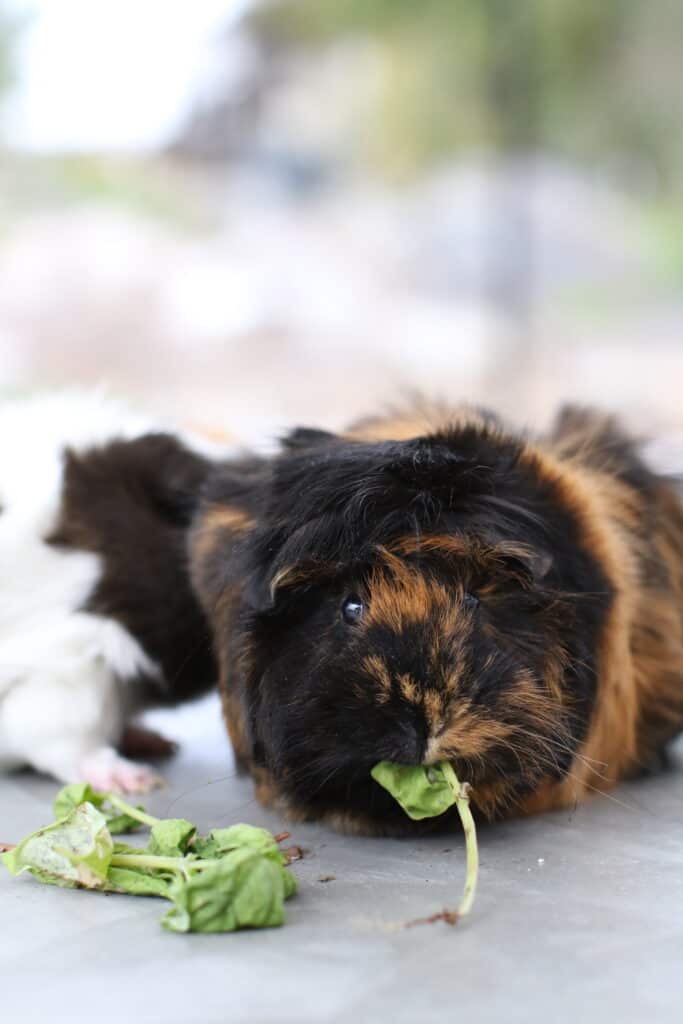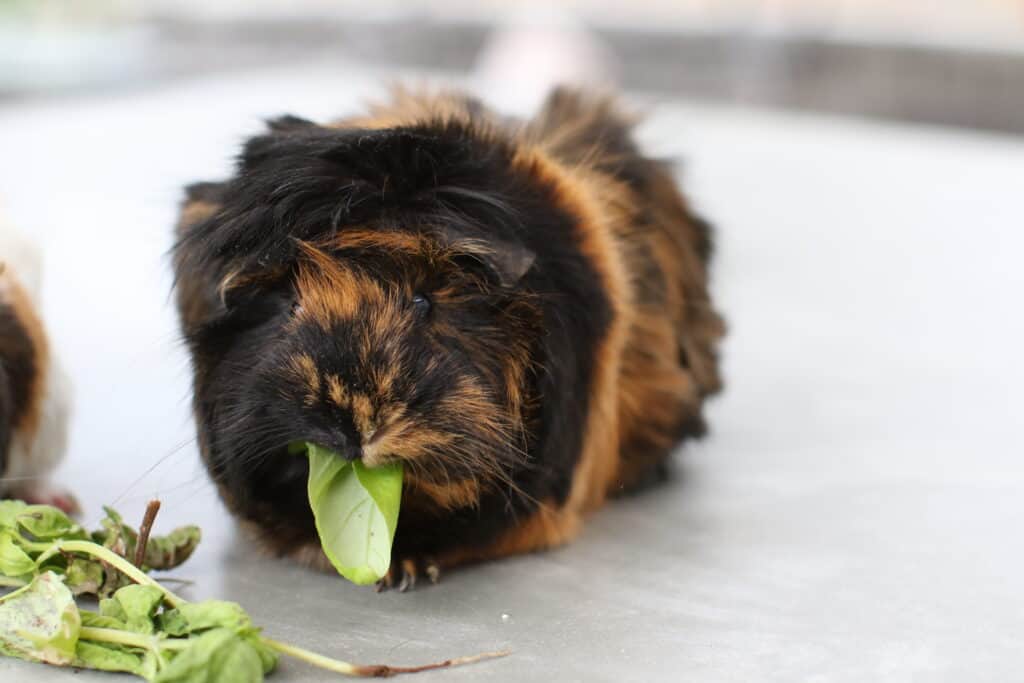As an Amazon Associate we earn from qualifying purchases.
Cavies are adorable in almost every way. Whether they’re small, scamper on their wheels, and stuff their cheeks with food, or whatever else there is to admire about them. In the course of my research, we discovered that guinea pig parents are currently asking if their pups can munch on tree leaves. So, can guinea pigs eat tree leaves?
Can Guinea Pigs Eat Tree Leaves?
Yes, guinea pigs can consume leaves and tree branches, but you must ensure that the plants are suitable for consumption.

Guinea pigs love apple tree leaves, banana leaves, kiwi leaves, and grape tree leaves, but you should avoid offering them poisonous plants such as tulip, iris, and leaves from the bluebell, among other plants. Plus, they like leaves from raspberry plants, guava plants, and marigolds.
Is It Possible For Guinea Pigs To Consume All Types Of Leaves?
Guinea pigs are the original vegetarian species. They are herbivores, which means they don’t eat meat and need a balanced diet. Guinea pigs can eat leaves. In the wild, these animals prefer to munch on grass, hay, tree bark, twigs, leaves, and other vegetation.
Cavies that are kept as pets have a more sophisticated taste, and they consume timothy hay shells, along with certain nutrients and vitamins.
Leaves can be used to entice your cavy’s wild side. If you want your cavy to engage with its untamed nature, offer it leaves. It’s not a good idea to go rambling around in your yard collecting the first tree you see for its leaves, however. Also, steer clear of any tree whose name you’re unsure about.
You should be particularly cautious about plant leaves as well. Plants that are poisonous to your cuddle bug include a variety of plants, especially evergreen plants, and plants that grow from bulbs.
Plants That Are Poisonous For Guinea Pigs
It is good to know about the plants that are poisonous to guinea pigs and life-threatening. If you’re going to feed your cavy plant, be careful not to walk past these poisonous plants.
- Lili of the valley
- Anemone
- Snowdrop
- Hyacinth
- Iris
- Bluebell
- Boxwood
- Laurel
- Bindweed
- Rhododendrons
- Chive
- Onion
- Leek
- Spring onion
- Garlic
- Ivy
Do Guinea Pigs Eat Maple Trees Leaves?
You could be tempted to offer your guinea pig leaves from a maple tree if you have one in your neighborhood. But do not succumb to that temptation because maple leaves are poisonous to guinea pigs. Maple leaves are great.
Maple leaves include the gallic acid that can be deadly to cavies if eaten. Even fresh or dead maple leaves contain this substance, which can cause death.
Is It Okay For Guinea Pigs To Eat Apple Tree Leaves?
Apple tree leaves are a tasty and beneficial treat for your cavy.
Humans may not want to eat the green stuff, but apple leaves are undoubtedly full of critical nutrients that are beneficial for their pet’s health. Furthermore, because there is no extra sugar to worry about, you won’t have to worry about your pet gaining weight.
Is It Safe For Guinea Pigs To Eat Apple Tree Branches?
Apple branches can be chewed on by guinea pigs since there are no harmful chemicals involved. However, clean and prepare the branch before offering it to your pig.
Remove the fruits’ stems, clean them with a brush, and then soak them in water. Remove tiny pieces of bark while trimming off any rough edges. It’s also a good idea to wash the apple branch in warm water for a few minutes to remove any pesticide residues.
Is It Okay For Guinea Pigs To Eat Mulberry Leaves?
Mulberries are high in Vitamin C and may be provided to cavies in small quantities. Similarly, mulberry bark and leaves can also be used as a nutritious and delicious treat for your cavy.
All you have to do now is let the leaves dry completely. Wash the leaves well to get rid of contaminants like insects, pesticides, and herbicides.

Is It Possible For A Guinea Pig To Consume Lemon Leaves?
Guinea pigs can eat leaves from lemon plants. Cavy lemons are high in Vitamin C, making them a wonderful treat as they are perfectly safe. In tiny amounts, they may be fed to your cavy since they contain this vitamin; too much of the citrus fruit, on the other hand, might cause stomach problems due to its acidic nature.
This is why it’s essential to avoid lemon leaves for your guinea pig, as they may cause several health problems.
What Are The Nutritional Benefits Of Tree Leaves For Guinea Pigs?
The nutritional advantages of feeding your cavy leaves will be determined by the sort of leaves you use. Regardless, there are numerous nutritional benefits that apply to all types of leaves. Here’s what they are:
They Help To Balance Electrolytes
Despite the fact that potassium is an important mineral, it somehow does not receive the credit it deserves. Potassium is an electrolyte as well as a key mineral for plant development.
Calcium is important for a healthy cavy because it can help the body’s fluid balance, muscular contractions, and nerve signals.
Low potassium levels can cause an electrolyte imbalance, which can result in a variety of worrisome symptoms such as tiredness, dizziness, lack of balance, and low blood pressure.
It Helps To Improve The Immunity System
Antioxidants are molecules that assist to destroy free radicals in all plants and trees.
Free radicals are the villains in science, linked to several diseases, such as diabetes, cancer, and heart disease. In music, they’re known as the next big band; in science, they’re the enemies of good health.
Cavies are prone to diabetes, which is why feeding them leaves that are high in antioxidants is a smart idea.
Antioxidants are also beneficial for the immune system. That implies your pet may grow a strong immune system that can fight infections and other illnesses.
Appetite, Mood, And Sleep Cycle Are All Improved
Tryptophan is an essential amino acid that may be found in most plants and is involved in sleep/wake regulation, hunger, and mood stabilization.
This amino acid is also required for guinea pig development and can aid in the prevention of cataracts.
Great For Scurvy Prevention
Guinea pigs are free of scurvy when given vitamin C. Guinea pigs are safe from scurvy due to the presence of vitamin C. This sickness might be deadly and, at first, causes a harsh coat, internal bleeding, loss of appetite, and swelling in the joints.
Gives An Energy Boost
The proteins and specific vitamins/minerals supplied by an adequate diet provide a boost of energy.
Improves Blood Function
Leaves are high in iron, which helps to maintain a healthy blood level and minimize the risk of anemia.
Ideal For Improving Oral Health
In guinea pigs, gnawing on leaves or branches prevents tooth overgrowth. They are born with this condition. That’s why they must chew on pellets or leaves and branches to avoid the awful teeth expansion.
What Are The Risks Of Feeding Tree Leaves To Guinea Pigs?
What could go wrong if you give your cany a healthy leaf diet? The answer is “quite a bit” if you don’t know what you’re doing.
Aside from the long list of poisonous leaves that cavies should avoid, there are a few disadvantages to feeding your pet plants.
Urinary Infections, Bacterial Infection, And Bladder Stones
Us, guinea pigs, and bladder stones are two things that don’t belong in the same sentence. Are cavy bladders really big enough to form stones?
Yes, that’s it exactly! That is why you should avoid feeding your cavy leaves too frequently because they may include calcium.
Guinea pigs that are pregnant or growing require a lot of calcium, but adult guinea pigs have a hard time with it.
Oxalate formation is triggered by calcium excess in your small pet’s body. Calcium oxalate kidney stones are a typical occurrence in cats, and excessive calcium can cause them. It can also lead to renal failure.
Furthermore, high calcium levels can promote the accumulation of the mineral in your cavy’s urinary tract (ow). This can cause urinary infections and frequent urination.
Bloating And Diarrhea
When you introduce your cavy to a new experience, there’s always the chance it won’t go over well.
Guinea pigs have a lot in common when it comes to physiologies, but your pet’s particular system may not follow the same rules. That implies that what works for other cavies may not work for you.
That’s why, after feeding their pet leaves to guinea pigs, some cavy owners have reported cases of diarrhea and/or bloating. Guinea pig diarrhea is a serious health problem that must be addressed immediately because it can lead to dehydration and in rare circumstances, death.
Bloating isn’t deadly, but it is certainly unpleasant for your little cavy to endure. So, go easy on him by starting with new food in tiny quantities first.
Stomach Upsets
Aside from that, anything that is consumed in excess amounts is not beneficial. As a result, excessive foliage or branches may irritate the guinea pig’s digestive system.
What Should Guinea Pigs Eat Of The Tree Branches?
Guinea pogs eat tree branches. Guinea pigs can easily chew a pear, apple, and willow twig and only certain types of branches.
However, avoid all stone fruit trees’ branches while feeding your cavies, such as plums or peaches.
Guinea pigs should never eat any tree branches. Plum, cherry, peach, apricot, and nectarine are just a few examples of harmful tree branches. This is due to the fact that stone fruit-bearing trees’ branches are poisonous in large quantities for cavies. In other words, they must not consume tree branches containing stone fruits in